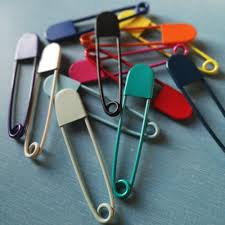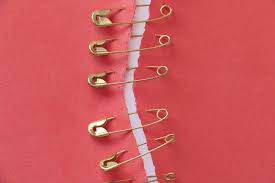The Versatile Safety Pin: A Small Tool with Big Uses
A safety pin is a simple yet ingenious device that has become an indispensable part of everyday life. Its design, featuring a spring mechanism and a protective clasp, not only makes it easy to use but also ensures safety by covering the sharp point. Originally created as a practical tool to fasten pieces of fabric together, safety pins have evolved to serve a multitude of purposes, from securing clothing to being used as a fashion accessory.
The Origins and Evolution of the Safety Pin
The safety pin, as we know it today, was invented in 1849 by Walter Hunt, an American mechanic. Hunt designed the safety pin as a solution to an unpaid debt, crafting a pin that could fasten securely without posing a risk to the user. His design included a clasp that both held the pin in place and shielded the sharp point, making it safer and more reliable than a regular pin.
While the basic design of the safety pin has remained largely unchanged since its invention, its uses have expanded significantly. What began as a simple tool for fastening fabric now plays a role in various aspects of daily life, including fashion, crafting, and even emergency repairs.
Practical Uses of Safety Pins

One of the most common uses of safety pins is in fastening clothing, particularly when a quick fix is needed. Whether it’s securing a broken zipper, temporarily hemming a skirt, or holding together a tear in fabric, safety pins provide a convenient and reliable solution. They are also widely used in the care of infants, particularly as nappy pins. These specialized safety pins come with extra secure covers to prevent accidental poking, making them ideal for fastening cloth diapers.
In the world of crafts and quilting, safety pins are indispensable tools. Quilters often use size 3 safety pins, also known as “quilting pins,” to hold fabric layers together while sewing. Larger sizes, such as size 4, are sometimes referred to as “blanket pins” and can even be used as informal kilt pins due to their size and strength.
Beyond their practical applications, safety pins have also found a place in fashion. They are often incorporated into jewelry designs, such as earrings, chains, and wristbands, adding an edgy or punk-inspired element to accessories. In addition, safety pins are frequently used to attach embroidered patches to clothing or bags, offering a customizable and temporary method of personalization.
Traveling with Safety Pins: TSA Guidelines
For travelers, safety pins are a handy item to have on hand, offering quick fixes for unexpected wardrobe malfunctions or serving as makeshift fasteners. However, the question arises: can you bring safety pins on a plane? According to the Transportation Security Administration (TSA), safety pins are generally permitted in both carry-on and checked luggage.
While safety pins are allowed, it’s important to pack them in a way that won’t raise concerns during security screenings. TSA agents have the final say on whether an item poses a security risk, so it’s wise to store safety pins in a small container or metal sewing box. This not only keeps them organized but also makes it easier for security personnel to quickly assess their purpose.
When traveling internationally, it’s essential to be aware that security regulations may vary from one country to another. However, safety pins are typically not classified as prohibited items on international flights. Still, it’s advisable to minimize the amount of metal in your carry-on baggage to avoid triggering metal detectors and potential delays.
Safety Pins in Fashion and Culture

Safety pins have transcended their original purpose and become symbols in various cultural contexts. In the punk fashion movement of the 1970s, safety pins were repurposed as accessories, often worn as earrings, on clothing, or as a statement of rebellion against the mainstream. This trend continues today, with safety pins symbolizing a DIY spirit and a rejection of conventional norms.
In more recent times, safety pins have taken on new symbolic meanings. Following the 2016 U.S. presidential election and the Brexit vote in the U.K., safety pins became a symbol of solidarity and safety. People wore them as a sign that they were allies to those who felt marginalized or threatened, using the simple pin to convey a powerful message of support and inclusivity.
Conclusion: The Enduring Utility of the Safety Pin
The safety pin, with its simple yet effective design, remains a versatile tool that has stood the test of time. From its humble beginnings as a practical fastener to its role in fashion, culture, and travel, the safety pin continues to be a valuable and symbolic item in everyday life. Whether you need a quick fix for a wardrobe malfunction or a way to express your individuality, the safety pin proves that even the smallest tools can have a big impact.




